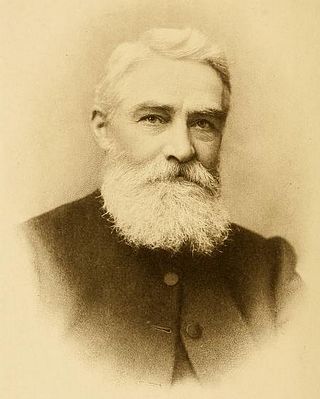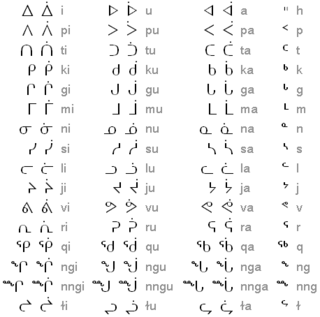An abjad is a writing system in which only consonants are represented, leaving vowel sounds to be inferred by the reader. This contrasts with alphabets, which provide graphemes for both consonants and vowels. The term was introduced in 1990 by Peter T. Daniels. Other terms for the same concept include: partial phonemic script, segmentally linear defective phonographic script, consonantary, consonant writing, and consonantal alphabet.

An abugida, sometimes known as alphasyllabary, neosyllabary or pseudo-alphabet, is a segmental writing system in which consonant–vowel sequences are written as units; each unit is based on a consonant letter, and vowel notation is secondary, like a diacritical mark. This contrasts with a full alphabet, in which vowels have status equal to consonants, and with an abjad, in which vowel marking is absent, partial, or optional – in less formal contexts, all three types of script may be termed "alphabets". The terms also contrast them with a syllabary, in which a single symbol denotes the combination of one consonant and one vowel.
In the linguistic study of written languages, a syllabary is a set of written symbols that represent the syllables or moras which make up words.

Cree is a dialect continuum of Algonquian languages spoken by approximately 117,000 people across Canada, from the Northwest Territories to Alberta to Labrador. If considered one language, it is the aboriginal language with the highest number of speakers in Canada. The only region where Cree has any official status is in the Northwest Territories, alongside eight other aboriginal languages. There, Cree is spoken mainly in Fort Smith and Hay River.

Edmund James Peck, known in Inuktitut as Uqammaq, was an Anglican missionary in the Canadian North on the Quebec coast of Hudson Bay and on Baffin Island. He founded the first permanent mission on Baffin Island, Nunavut. He developed Inuktitut syllabics, derived from the Cree syllabary and the first substantial English-Inuktitut dictionary.

Inuktitut syllabics is an abugida-type writing system used in Canada by the Inuktitut-speaking Inuit of the territory of Nunavut and the Nunavik and Nunatsiavut regions of Quebec and Labrador, respectively. In 1976, the Language Commission of the Inuit Cultural Institute made it the co-official script for the Inuit languages, along with the Latin script.
Algonquin is either a distinct Algonquian language closely related to the Ojibwe language or a particularly divergent Ojibwe dialect. It is spoken, alongside French and to some extent English, by the Algonquin First Nations of Quebec and Ontario. As of 2006, there were 2,680 Algonquin speakers, less than 10% of whom were monolingual. Algonquin is the language for which the entire Algonquian language subgroup is named; the similarity among the names often causes considerable confusion. Like many Native American languages, it is strongly verb-based, with most meaning being incorporated into verbs instead of using separate words for prepositions, tense, etc.

Ojibwe, also known as Ojibwa, Ojibway, Otchipwe, Ojibwemowin, or Anishinaabemowin, is an indigenous language of North America of the Algonquian language family. The language is characterized by a series of dialects that have local names and frequently local writing systems. There is no single dialect that is considered the most prestigious or most prominent, and no standard writing system that covers all dialects.

Inuktitut, also known as Eastern Canadian Inuktitut, is one of the principal Inuit languages of Canada. It is spoken in all areas north of the North American tree line, including parts of the provinces of Newfoundland and Labrador, Quebec, to some extent in northeastern Manitoba as well as the Northwest Territories and Nunavut. It is one of the aboriginal languages written with Canadian Aboriginal syllabics.

Canadian syllabic writing, or simply syllabics, is a family of writing systems used in a number of Indigenous Canadian languages of the Algonquian, Inuit, and (formerly) Athabaskan language families. These languages had no formal writing system previously. They are valued for their distinctiveness from the Latin script and for the ease with which literacy can be achieved. For instance, by the late 19th century the Cree had achieved what may have been one of the highest rates of literacy in the world.

Western Cree syllabics are a variant of Canadian Aboriginal syllabics used to write Plains Cree, Woods Cree and the western dialects of Swampy Cree. It is used for all Cree dialects west of approximately the Manitoba–Ontario border in Canada, as opposed to Eastern Cree syllabics. It is also occasionally used by a few Cree speakers in the United States.
Eastern Cree syllabics are a variant of Canadian Aboriginal syllabics used to write all the Cree dialects from Moosonee, Ontario to Kawawachikamach on the Quebec–Labrador border in Canada that use syllabics.

Plains Cree is a dialect of the Algonquian language, Cree, which is the most populous Canadian indigenous language. Plains Cree is considered a dialect of the Cree-Montagnais language or a dialect of the Cree language that is distinct from the Montagnais language. Plains Cree is one of five main dialects of Cree in this second sense, along with Woods Cree, Swampy Cree, Moose Cree, and Atikamekw. Although no single dialect of Cree is favored over another, Plains Cree is the one that is the most widely used. Out of the 116,500 speakers of the Cree language, the Plains Cree dialect is spoken by about 34,000 people primarily in Saskatchewan and Alberta but also in Manitoba and Montana.
Great Lakes Algonquian syllabics is a writing system for several Algonquian languages that emerged during the nineteenth century and whose existence was first noted in 1880. It was originally used near the Great Lakes: Fox, Sac, and Kickapoo, in addition to Potawatomi. Use of the script was subsequently extended to the Siouan language Ho-Chunk. Use of the Great Lakes script has also been attributed to speakers of the Ottawa dialect of the Ojibwe language, but supporting evidence is weak.
The phonology of the Ojibwe language varies from dialect to dialect, but all varieties share common features. Ojibwe is an indigenous language of the Algonquian language family spoken in Canada and the United States in the areas surrounding the Great Lakes, and westward onto the northern plains in both countries, as well as in northeastern Ontario and northwestern Quebec. The article on Ojibwe dialects discusses linguistic variation in more detail, and contains links to separate articles on each dialect. There is no standard language and no dialect that is accepted as representing a standard. Ojibwe words in this article are written in the practical orthography commonly known as the Double vowel system.

Ojibwe is an indigenous language of North America from the Algonquian language family. Ojibwe is one of the largest Native American languages north of Mexico in terms of number of speakers and is characterized by a series of dialects, some of which differ significantly. The dialects of Ojibwe are spoken in Canada from southwestern Quebec, through Ontario, Manitoba and parts of Saskatchewan, with outlying communities in Alberta and British Columbia, and in the United States from Michigan through Wisconsin and Minnesota, with a number of communities in North Dakota and Montana, as well as migrant groups in Kansas and Oklahoma.
The Severn Ojibwa or the Oji-Cree language is the indigenous name for a dialect of the Ojibwe language spoken in a series of Oji-Cree communities in northern Ontario and at Island Lake, Manitoba, Canada. Ojibwa is a member of the Algonquian language family, itself a member of the Algic language family.
The Ojibwe language is spoken in a series of dialects occupying adjacent territories, forming a language complex in which mutual intelligibility between adjacent dialects may be comparatively high but declines between some non-adjacent dialects. Mutual intelligibility between some non-adjacent dialects, notably Ottawa, Severn Ojibwe, and Algonquin, is low enough that they could be considered distinct languages. There is no single dialect that is considered the most prestigious or most prominent, and no standard writing system that covers all dialects. The relative autonomy of the regional dialects of Ojibwe is associated with an absence of linguistic or political unity among Ojibwe-speaking groups.
Inuktitut Braille is a proposed braille alphabet of the Inuktitut language based on Inuktitut syllabics. Unlike syllabics, it is a true alphabet, with separate letters for consonants and vowels, though vowels are written before the consonants they follow in speech. It was published in 2012 by Tamara Kearney, Manager of Braille Research and Development at the Commonwealth Braille and Talking Book Cooperative. The book ᐃᓕᐊᕐᔪᒃ ᓇᓄᕐᓗ The Orphan and the Polar Bear was the first work transliterated into Inuktitut Braille.











